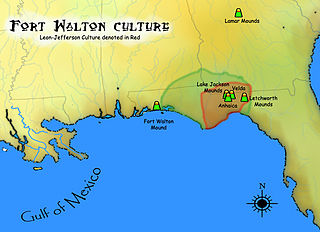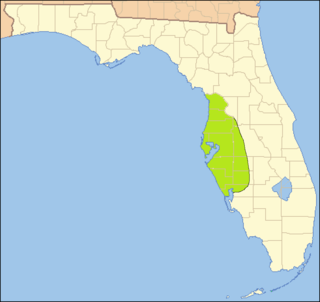
The Mississippian culture was a Native American civilization that flourished in what is now the Midwestern, Eastern, and Southeastern United States from approximately 800 to 1600, varying regionally. It was known for building large, earthen platform mounds, and often other shaped mounds as well. It was composed of a series of urban settlements and satellite villages linked together by loose trading networks. The largest city was Cahokia, believed to be a major religious center located in what is present-day southern Illinois.

Lake Jackson Mounds Archaeological State Park (8LE1) is one of the most important archaeological sites in Florida, the capital of chiefdom and ceremonial center of the Fort Walton Culture inhabited from 1050–1500. The complex originally included seven earthwork mounds, a public plaza and numerous individual village residences.

The Apalachee were an Indigenous people of the Southeastern Woodlands, specifically an Indigenous people of Florida, who lived in the Florida Panhandle until the early 18th century. They lived between the Aucilla River and Ochlockonee River, at the head of Apalachee Bay, an area known as the Apalachee Province. They spoke a Muskogean language called Apalachee, which is now extinct.

The Weeden Island cultures are a group of related archaeological cultures that existed during the Late Woodland period of the North American Southeast. The name for this group of cultures was derived from the Weedon Island site in Old Tampa Bay in Pinellas County.

Anhaica was the principal town of the Apalachee people, located in what is now Tallahassee, Florida. In the early period of Spanish colonization, it was the capital of the Apalachee Province. The site, now known as Martin Archaeological Site, was rediscovered in 1988.
The history of Leon County, Florida, much like the History of Tallahassee, dates back to the settlement of the Americas. Beginning in the 16th century, the region was colonized by Europeans, becoming part of Spanish Florida. In 1819, the Adams–Onís Treaty ceded Spanish Florida, including modern-day Leon County, to the United States. Named for Spanish explorer Juan Ponce de León, Leon County became an official U.S. county in 1824; the American takeover led to the county's rapid expansion as growing numbers of cotton plantations began to spring up nearby, increasing Leon County's population significantly.

The Leon-Jefferson Culture is the term used by archaeologists for a protohistoric Native American archaeological culture that flourished in southeastern North America from approximately 1500–1704 CE and is associated with the historic Apalachee people. It was located in and named for the present day Leon and Jefferson counties in northern Florida of the Southeastern United States

Apalachee Province was the area in the Panhandle of the present-day U.S. state of Florida inhabited by the Native American peoples known as the Apalachee at the time of European contact. The southernmost extent of the Mississippian culture, the Apalachee lived in what is now Leon County, Wakulla County and Jefferson County. The name was in use during the early period of European exploration. During Spanish colonization, the Apalachee Province became one of the four major provinces in the Spanish mission system, the others being the Timucua Province,, the Mocama Province and the Guale Province.

The Fort Walton Mound (8OK6) is an archaeological site located in present-day Fort Walton Beach, Florida, United States. The large platform mound was built about 850 CE by the Pensacola culture, a local form of the Mississippian culture. Because of its significance, the mound was designated a National Historic Landmark in 1964.
Velda Mound (8LE44) is a Native American archaeological site located in northern Tallahassee, Leon County, Florida, United States. The site was first occupied by peoples of the Fort Walton Culture in the late prehistoric period and during the protohistoric period was part of the extensive Apalachee Province of the panhandle. The site is now owned by the State of Florida and managed as a park.

The Plaquemine culture was an archaeological culture centered on the Lower Mississippi River valley. It had a deep history in the area stretching back through the earlier Coles Creek and Troyville cultures to the Marksville culture. The Natchez and related Taensa peoples were their historic period descendants. The type site for the culture is the Medora site in Louisiana; while other examples include the Anna, Emerald, Holly Bluff, and Winterville sites in Mississippi.

The Safety Harbor culture was an archaeological culture practiced by Native Americans living on the central Gulf coast of the Florida peninsula, from about 900 CE until after 1700. The Safety Harbor culture is defined by the presence of Safety Harbor ceramics in burial mounds. The culture is named after the Safety Harbor site, which is close to the center of the culture area. The Safety Harbor site is the probable location of the chief town of the Tocobaga, the best known of the groups practicing the Safety Harbor culture.

Mississippian culture pottery is the ceramic tradition of the Mississippian culture found as artifacts in archaeological sites in the American Midwest and Southeast. It is often characterized by the adoption and use of riverine shell-tempering agents in the clay paste. Shell tempering is one of the hallmarks of Mississippian cultural practices. Analysis of local differences in materials, techniques, forms, and designs is a primary means for archaeologists to learn about the lifeways, religious practices, trade, and interaction among Mississippian peoples. The value of this pottery on the illegal antiquities market has led to extensive looting of sites.
The Pensacola were a Native American people who lived in the western part of what is now the Florida Panhandle and eastern Alabama for centuries before first contact with Europeans until early in the 18th century. They spoke a Muskogean language. They are the source of the name of Pensacola Bay and the city of Pensacola. They lived in the area until the mid-18th century, but were thereafter assimilated into other groups.
The Lamar mounds and village site (9BI2) is an important archaeological site on the banks of the Ocmulgee River in Bibb County, Georgia, several miles to the southeast of the Ocmulgee mound site. Both mound sites are part of the Ocmulgee Mounds National Historical Park, a national park and historic district created in 1936 and run by the U.S. National Park Service. Historians and archaeologists have theorized that the site is the location of the main village of the Ichisi encountered by the Hernando de Soto expedition in 1539.

The Pensacola culture was a regional variation of the Mississippian culture along the Gulf Coast of the United States that lasted from 1100 to 1700 CE. The archaeological culture covers an area stretching from a transitional Pensacola/Fort Walton culture zone at Choctawhatchee Bay in Florida to the eastern side of the Mississippi River Delta near Biloxi, Mississippi, with the majority of its sites located along Mobile Bay in the Mobile-Tensaw River Delta. Sites for the culture stretched inland, north into the southern Tombigee and Alabama River valleys, as far as the vicinity of Selma, Alabama.
The Sims site (16SC2), also known as Sims Place site, is an archaeological site located in Saint Charles Parish, Louisiana, near the town of Paradis. The location is a multi-component mound and village complex with platform mounds and extensive midden deposits. The site habitations are divided into three periods. It was first inhabited about 800 CE by peoples of the Coastal Coles Creek culture. By 1100 CE the culture of the site had transitioned into the Mississippianized Plaquemine culture that lasted until 1450 CE. A little later was a Late Mississippian/protohistoric period that lasted from 1500 until about 1700 or 1800.
The Suwannee Valley culture is defined as a Late Woodland Southeast period archaeological culture in north Florida, dating from around 750 to European contact. The core area of the culture was found in an area roughly corresponding to present-day Suwannee and southern and central Columbia counties. It was preceded by the McKeithen Weeden Island culture and followed by the Spanish mission period Leon-Jefferson culture.

The Vincennes phase is a Mississippian culture phase dating from 1100-1350 CE. This poorly-understood phase occupied much of the Lower Wabash Valley in western Indiana and eastern Illinois. Robert Barth proposed that the Vincennes phase evolved from the Allison-Lamotte culture, however this isn't universally agreed upon. The Vincennes phase people were agriculturalists, dependant on maize to sustain their population. They were a multi-ethnic people, composed of cultural traits from Middle Mississippian, Upper Mississippian, Fort Ancient, and Woodland cultures.
















